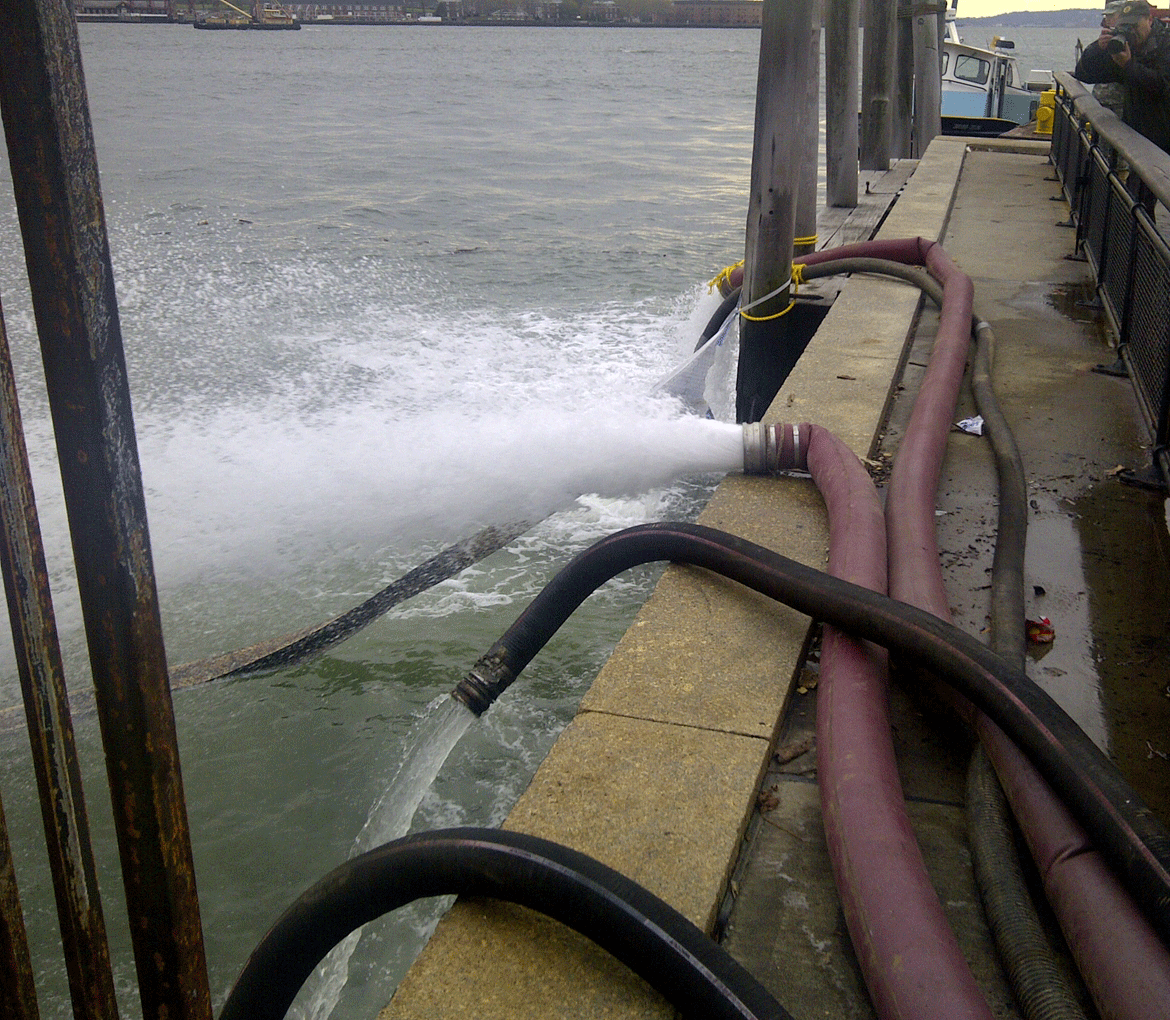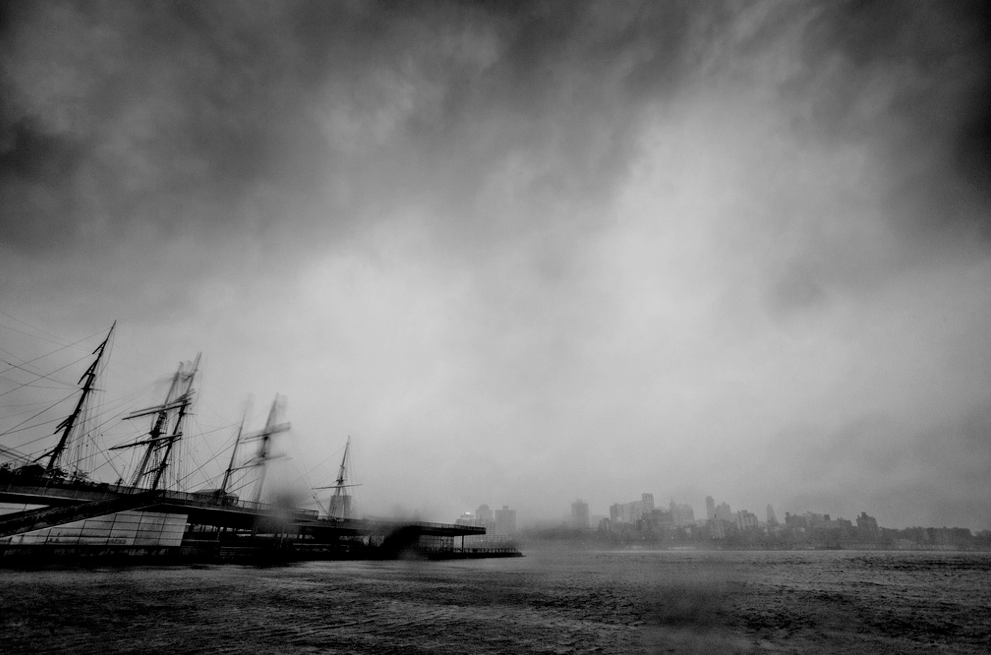Adapting Cities to Climate Disruption
Air Date: Week of November 9, 2012

Pumping water out of New York City. (US Army Corps of Engineers)
Superstorm Sandy drew some of its strength from warmer waters, exacerbated by climate change. Elliott Sclar, director of the Center for Sustainable Urban Development at the Earth Institute at Columbia University tells host Steve Curwood how to design urban areas to be more resilient in a warming world.
Transcript
CURWOOD: It’s Living on Earth, I'm Steve Curwood. The Superstorm called Sandy was a wake-up call in the US, laying bare the vulnerabilities of our built environment in the face of dangerous new realities of climate disruption. Rising sea levels and severe storm surges target coastal communities, and many towns and cities are inadequately protected.
So the question is, what are we going to do about it? It's the kind of problem that engages thinkers like Dr. Elliott Sclar. He directs the Center for Sustainable Urban Development at Columbia University's Earth Institute - and joins us by skype welcome to Living on Earth!
SCLAR: Thank you, it’s nice to be with you!
CURWOOD: So, how surprised were you by that damage that was caused by Hurricane Sandy?
SCLAR: Well, I was surprised and I wasn’t surprised. I obviously was surprised by the timing of it and knowing what the actual extent of the damage was, but as an economist and as an urban planner who deals with sustainable cities, the notion that this was going to happen was not something that came out of the blue to me. So, in that sense, it was kind of one of those moments when you know… well, I told you so. But I didn’t say that because it’s really a serious problem for lots of people.
CURWOOD: A lot of the efforts at climate change legislation in this country, really around the world, have been aimed at reducing emissions. What should we be doing now to get a coherent policy on adaptation?
SCLAR: That’s a very important point. While we do have to mitigate, even if we were to end all greenhouse gas emissions tomorrow, there still would be a major problem going forward because of all of the carbon that’s accumulating in the atmosphere already.
The real question is: What are we going to do to adapt to the new realities of the climate that we face. Some of the answers that you’re hearing are probably technical ones – protection against storm surges for coastal communities is one of the things that you hear, hardening infrastructures against flooding conditions. The issue that we face is how are we going to begin to accomplish the kinds of changes that we need to put in place.
As you know, if you followed the last few years of the debates in Congress about cap and trade, mitigation doesn’t sell very well. But I do believe that adaption is going to sell a lot better. One of the things that Sandy did was create a democratic crisis. By democratic crisis, I don’t mean a political crisis. I mean people rich and poor all were affected by this storm. In the past, a lot of events that created a lot of dislocation were felt disproportionately by poorer peoples. For example, Katrina was largely a story of the 9th ward and the way poor people fared in that storm.
In this particular storm, people living in lower Manhattan, some of the most affluent people in the country, perhaps in the world, were walking around with flashlights, and didn’t have power, didn’t have heat depending upon the kinds of systems that they had. This is very much like what happened in the 19th century when we were dealing with things like cholera epidemics before we understood what germs were.
There was… it became very clear that the only protection for the rich was going to be the protection of everybody else. And when you get that kind of political cohesiveness, we really do have a chance to make something change.

Hurricane Sandy rolls into New York City (Photo: Zoriah)
CURWOOD: What about things like marshes and rain gardens on roofs in the city, permeable concrete on roofs to help deal with the run-off. How much should we be thinking about those kinds of things?
SCLAR: All of those are good ideas. Those are things we teach, those are things we preach, green roofs, painting roofs white to better reflect heat, forms of more permeable concrete in parking lots. All of those things are things that we talk about but we’re going to have to go a lot further. It’s technical, but it’s also social. It’s got to be social policy, it’s got to be land-use policy, it’s going to have to be infrastructure policy, and it really is going to have to be the use of government incentives.
We have to begin to incentivize people to live in walk-able and bike-able communities. Right now all the incentives that we have are to build more highways and to move more people out – and that isn’t just an American problem. I’m confronting the same problem on doing planning in African cities, in Nairobi right now.
This really is going to take developing a broad-based understanding about what these issues are, and I think that we have an opening for this dialogue right now. It really is a question of bringing the society together and I think things like the common threat of something like the storm gives us a shot at it.
CURWOOD: What about the question of rebuilding infrastructure that has been damaged by the storm? And how many of the places that have been damaged should we even think about rebuilding?
SCLAR: That’s one of those questions I teach my graduate students to begin answering by saying: Well it depends! You have to really look critically at the infrastructure in those places and begin to think about: what can be rebuilt where?
That’s one of those questions I think that we’re going to be asking and I think we have to ask, but it’s not a question that you just say in a general sense: well, we’re going to have to get rid of things. Well, we’re going to have to learn how to adapt things more.
CURWOOD: With rising sea levels and storm surges increasing, how do you incentivize living away from the water?
SCLAR: You’ve got to break that into two parts. Certainly, for higher income groups, the notion of waterfront living has been something that has been very attractive. It is attractive to live by the water and to sit by the water… water can be very calming and soothing. But one of the things that we have to do is we have to talk about insurance and saying that… if you want to live there, you have to pay for it. You have to bear the risk if that’s your choice.
But I would be cautious about that because there are a lot of people on Staten Island who are living by the water who are not affluent people. There’s a lot of working-class and poor communities that are in those places because they were low-lying places. The 9th Ward in New Orleans, was not a ‘tony’ neighborhood. So those people do not need to be lectured to and told that they’ve made bad choices. They made the best choice given the options that were open to them.
And what we have to do is talk about this not as just an issue of environmental policy, but it’s an issue of social policy as well. We have to really talk about how we create opportunities for housing that works in other places. We have to really begin to pull this apart in a much more communal and democratic way.
CURWOOD: Elliott Sclar, what’s the silver lining to all this?
SCLAR: You know, where you stand has a lot to do with where you sit, I guess. The people who’ve been badly wiped out, I don’t think they see any silver linings. For people who have lost their homes, who are sleeping on cots in shelters right now, who were living comfortable lives up until a week ago, I’m not sure they see a silver lining.
For those of us who do urban planning and sustainability, what we see is a chance to make people understand why we are so concerned about climate change, why we have been sounding the alarms that we’ve been sounding, why we’ve been trying to get the attention of politicians. So, if that’s a silver lining, we got it!
CURWOOD: Elliott Sclar is Director for Sustainable Development at Columbia’s Earth Institute, Professor, thanks so much for taking this time!
SCLAR: My pleasure.
Living on Earth wants to hear from you!
Living on Earth
62 Calef Highway, Suite 212
Lee, NH 03861
Telephone: 617-287-4121
E-mail: comments@loe.org
Newsletter [Click here]
Donate to Living on Earth!
Living on Earth is an independent media program and relies entirely on contributions from listeners and institutions supporting public service. Please donate now to preserve an independent environmental voice.
NewsletterLiving on Earth offers a weekly delivery of the show's rundown to your mailbox. Sign up for our newsletter today!
 Sailors For The Sea: Be the change you want to sea.
Sailors For The Sea: Be the change you want to sea.
 The Grantham Foundation for the Protection of the Environment: Committed to protecting and improving the health of the global environment.
The Grantham Foundation for the Protection of the Environment: Committed to protecting and improving the health of the global environment.
 Contribute to Living on Earth and receive, as our gift to you, an archival print of one of Mark Seth Lender's extraordinary wildlife photographs. Follow the link to see Mark's current collection of photographs.
Contribute to Living on Earth and receive, as our gift to you, an archival print of one of Mark Seth Lender's extraordinary wildlife photographs. Follow the link to see Mark's current collection of photographs.
 Buy a signed copy of Mark Seth Lender's book Smeagull the Seagull & support Living on Earth
Buy a signed copy of Mark Seth Lender's book Smeagull the Seagull & support Living on Earth

